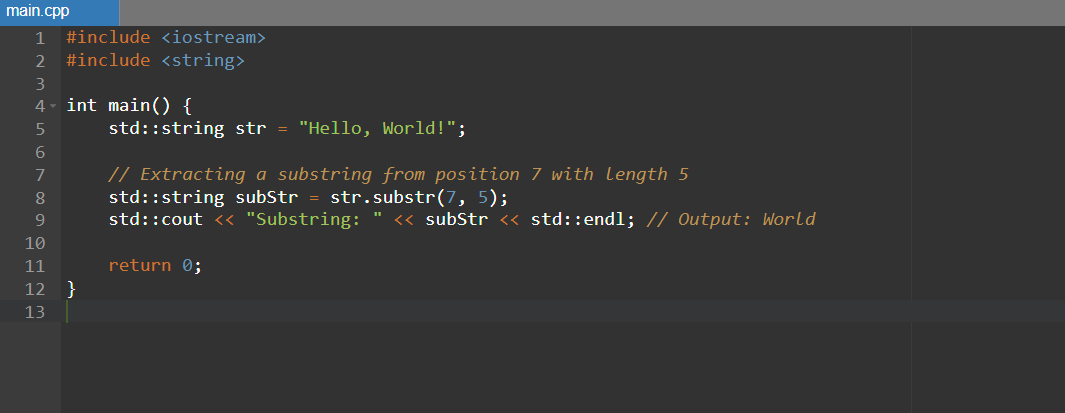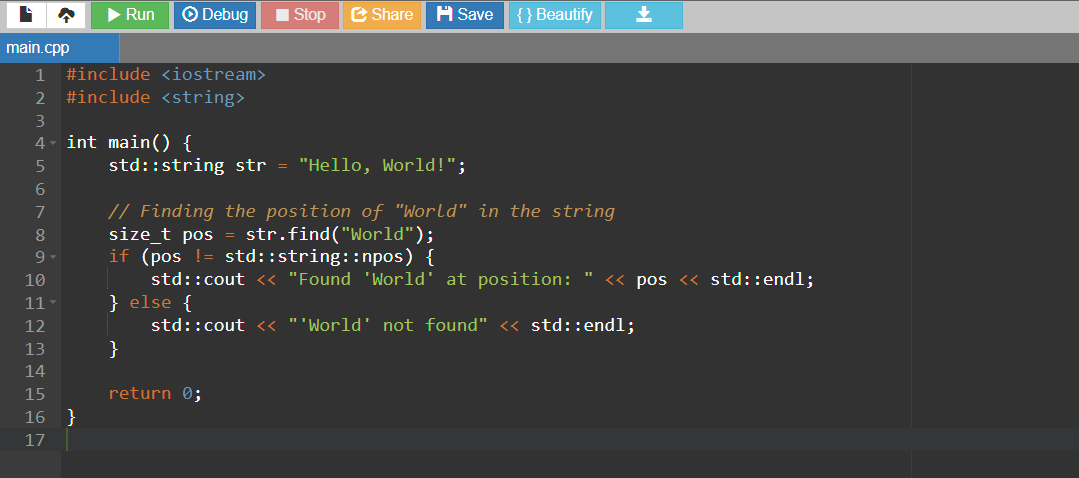Working professionals
Fresh graduates
- Study abroad
- Offline centres
More
4. C++ Variable
10. C++ for Loop
12. C++ Lambda
13. Loop in C++
15. Array in C++
16. Strings in C++
17. Substring in C++
29. Vector in C++
30. Map in C++
31. Pair in C++
33. Iterators in C++
34. Queue in C++
36. Stack in C++
37. ifstream in C++
40. Templates in C++
43. Namespace in C++
46. Recursion in C++
48. C++ Shell
49. Setw in C++
51. Atoi in C++
54. C# vs C++
55. C++ GUI
56. C++ Game Code
57. Class in C++
58. C++ Header Files
63. Cin in C++
64. Printf in C++
65. Struct in C++
66. C++ List
68. C++ Comments
72. Sorting in C++
Substrings in C++: Complete Guide & Examples
Today, I am going to delve into a topic that is very interesting and highly practical in the realm of C++ programming - the substring. If you ever thought about how to pull out a section from a string or handle strings with efficiency, this is for you. In this guide, I will take you through all necessary details regarding the substring function in C++. Next, we will discuss how to use it, why it is strong and show some useful samples.
At the end of this article, you should have a strong understanding about how to find substring in string C++ and use these methods for your own tasks.
Additionally, if you want to improve your string manipulation abilities and become more skilled in C++, let's begin! Also, when you wish to extend your learning further, think about looking into upGrad's software engineering classes for a deeper understanding and hands-on practice. Now we can start our journey together into the world of substring in C++.
What is a Substring in C++?
In simple terms, a substring is a sequence of characters that appears consecutively within a string. In C++, the substring function in C++ helps us extract these sequences based on our requirements.
For example, if we have a string "Hello, World!", a substring could be "Hello", "World", or even "lo, Wo".
The Substr Function for Working with Substring in C++
The substr function in C++ is a member function of the std::string class. It allows us to extract a specific portion of a string. The basic syntax of the substr function looks like this:
std::string substr (size_t pos = 0, size_t len = npos) const;
Parameters:
- pos: The position of the first character to be copied.
- len: The number of characters to include in the substring.
Examples:
Let’s take a look at some practical examples to understand how substring in CPP works.
Example:

Output:

Code:
#include <iostream>
#include <string>
int main() {
std::string str = "Hello, World!";
// Extracting a substring from position 7 with length 5
std::string subStr = str.substr(7, 5);
std::cout << "Substring: " << subStr << std::endl; // Output: World
return 0;
}
In the above code, str.substr(7, 5) extracts the substring "World" starting from position 7 and spanning 5 characters.
Find Substring in String C++
Another useful aspect of working with substring in C++ is finding them within a string. This is often done using the find function.
Example:

Output:

Code:
#include <iostream>
#include <string>
int main() {
std::string str = "Hello, World!";
// Finding the position of "World" in the string
size_t pos = str.find("World");
if (pos != std::string::npos) {
std::cout << "Found 'World' at position: " << pos << std::endl;
} else {
std::cout << "'World' not found" << std::endl;
}
return 0;
}
In this example, str.find("World") returns the position 7, indicating that the substring "World" starts at index 7.
Key Things to Remember When Working with Substrings in CPP
When dealing with substring in C++, you need to consider some key points so that you use the substr function and other related operations effectively and accurately.
- Positions counted from zero: Keep in mind that strings in C++ are indexed starting from 0. This indicates the initial character is at position 0.
- Immutability: The substr function doesn't change the original string; rather, it provides a fresh string object.
- Bounds checking: Be certain that your start position and length are within the string's bounds, to prevent runtime errors
- Handling npos: The npos constant is essential to handle correctly in your code. It represents the largest possible value for size_t, and it's employed for indicating that no matches were found in functions such as find.
- Efficiency considerations: Even though substr has a time complexity of O(n), where n is the number of characters in the substring, it's important to use it cautiously inside loops to prevent needless performance problems.
- Substrings that can't be changed: The substrings given back by substr are separate from the initial string. Any adjustments made to the substring will not modify the primary string in any way.
- Using the find function: Find is a very useful function when you want to search for a substring in a string and it will return the position of the first occurrence of that substring, or npos if it cannot be found.
- Special situations: Consider special situations like taking out a substring from an empty string, or when the starting point is at the same spot as the string's length. Taking care of these situations can avoid unexpected outcomes.
When you remember these important parts, working with substring in C++ is easier and you don't make simple mistakes. If you want to learn more and improve your programming abilities, think about joining upGrad's software engineering classes. They have thorough study routes and practical projects for boosting your coding skills.
Also, I am providing you with some exercise problems. Attempt to solve them in order to improve your proficiency in handling substring in C++.
Practice Questions on Substring in C++
Here are some practice questions to help you get hands-on experience with substrings in C++. Try solving these to deepen your understanding.
1. Extracting a substring
Create a function which receives a string and two integers (beginning point and size), then returns the matching substring.
2. Finding a substring
Create a program that discovers every instance of a substring within a provided string. It should output the positions where these substrings are located.
3. Replace a substring
Create a function that will substitute every appearance of a substring with another substring in an input string.
4. Check palindromic substring
Write a function which confirms if a provided substring in a string is palindrome or not.
5. Count substrings
Make a function that takes a string and substring as input, then counts how many times the substring occurs in the given string.
6. Longest substring without repeating characters
Create a function to discover the length of the greatest substring that contains no duplicate characters within a provided string.
Concluding Remarks
Handling substring in C++ is a necessary ability for any programmer involved in text manipulation. Whether you are dividing strings, looking for certain patterns or just taking out small parts of data, being skilled at the substring function in C++ and comprehending its subtleties can greatly improve your coding abilities.
To begin with, having comprehension of the basics regarding substring function in C++ is very important. This function lets you effortlessly extract any portion of a string by giving starting position and length. Basically, it assists you to separate out the particular part from a string. Apart from the usual extraction feature, you often have to find substring in string C++ as it has many applications like editing texts, parsing data and recognizing patterns. Utilizing functions like find in conjunction with the substring function simplifies these operations significantly.
Also, it is crucial to consider efficiency when working with substrings. Understand the complexity of these operations and fine-tune your code accordingly, particularly for big strings or if you are performing many substring tasks. Efficient management of strings can greatly impact how well your programs perform.
Avoiding common errors is just as crucial. Do remember to watch out for things like errors that are out-of-bounds, dealing with empty strings and making sure you use zero-indexed positions in the right way. These thoughts can help your code work correctly without any bugs.
The skill to work with substring in C++ is very useful for many different tasks, ranging from simple string operations to intricate algorithms used in fields such as data analysis, natural language processing and software building. By following these methods and comprehending the core rules involved, you can manage strings more confidently and accurately in C++.
I suggest that you investigate upGrad's software engineering courses if you desire to further your understanding and acquire practical skills. These classes offer a well-rounded comprehension of programming ideas, hands-on tasks from actual life scenarios, and the guidance of professionals for developing your abilities as a skilled software engineer. Thank you for accompanying me on this exploration about substrings in C++. I hope that this tutorial has been helpful and enjoyable for you. If there are any questions or more help needed, please let me know. Enjoy your coding!
FAQs
1. What is Substr() in C++?
The substr() function in C++ is used to extract a substring from a given string starting at a specified position for a certain length.
2. What is the Substr syntax?
The syntax for the substr function is std::string substr (size_t pos = 0, size_t len = npos) const;.
3. What is the complexity of Substr in C++?
The time complexity of substr() is O(n), where n is the number of characters to be copied into the substring.
4. What does Substr() do?
The substr() function extracts and returns a portion of the string starting from the specified position and extending for the given length.
5. How do I extract a substring from a string in C++?
You can extract a substring using the substr function. For example, str.substr(7, 5) extracts a substring starting from index 7 with a length of 5 characters.
6. Does the substr() function modify the original string?
No, the substr() function does not modify the original string. It returns a new string object containing the specified substring.
7. Can I modify the substring returned by substr()?
Yes, you can modify the substring returned by substr() since it is a separate string object.
8. Are substrings in C++ zero-indexed?
Yes, substrings in C++ are zero-indexed, meaning the first character of the string is at index 0.
9. Is the substr() function efficient?
The substr() function is generally efficient with a linear time complexity relative to the number of characters copied.
10. What is the difference between Substr and substring?
In C++, substr is the actual function used for substring extraction. The term "substring" is a general concept referring to any sequence of characters within a string.
Author|0


upGrad Learner Support
Talk to our experts. We are available 7 days a week, 10 AM to 7 PM
Indian Nationals
Foreign Nationals
Disclaimer
The above statistics depend on various factors and individual results may vary. Past performance is no guarantee of future results.
The student assumes full responsibility for all expenses associated with visas, travel, & related costs. upGrad does not .






















-7f4b4f34e09d42bfa73b58f4a230cffa.webp&w=128&q=75)
-ae8d039bbd2a41318308f8d26b52ac8f.svg)


